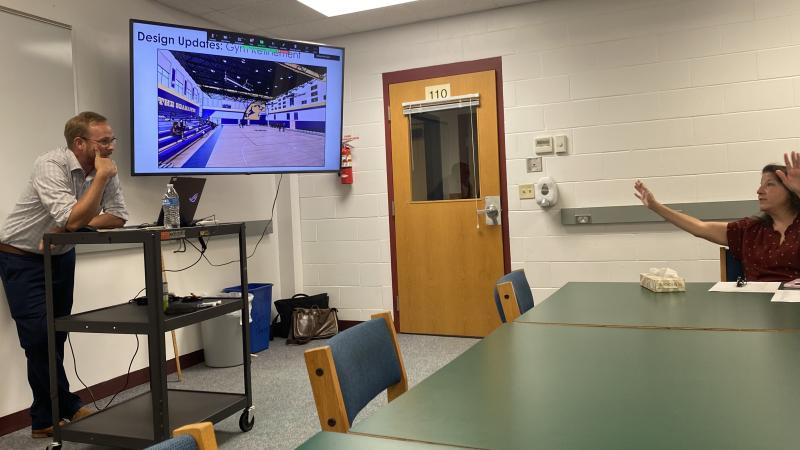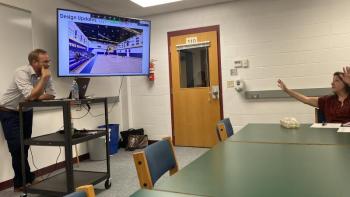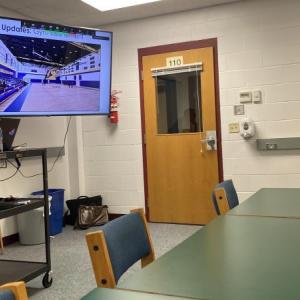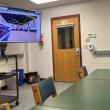BEC gets schematic update
Lavallee Brensinger architect Joe Britton presented updated building schematics to the Boothbay-Boothbay Harbor Community School District Building Exploratory Committee Aug. 24. Changes included reorientation of the 600-seat auditorium layout, a reworking of the outdoor area between school buildings and fresh design elements for the auditorium and gymnasium. Britton gave brief 3D tours of each.
The auditorium was first oriented with the audience facing northeast; a stairwell from the 400-seat ground floor gave access to a 200-seat balcony. Rotating the space to the northwest provides some cost-effective measures to structure and better use of the surrounding space, said Britton. It also provides about 400 square feet extra for the library, better integration with the surrounding learning spaces and a separate, on-grade entrance to balcony seating, he said.
“The steel is spanning, top to bottom, close to a 65-feet run. Steel needs a long-span joist and when you put a third floor above it, it's a very complicated and very costly solution to do that. By rotating the auditorium ... our span is 42 feet ... so we just saved a whole bunch of money.”
The downside to the alterations is that the balcony seat count drops to 156 for a total of 556 which is not ideal in accommodating a district-wide assembly as principals and teaching staff prefer. BRHS Principal Tricia Campbell said when LBPA sat down with administrators and teachers, they identified the need for about 600 seats for the BRHS and BRES population and staff. It would also make it feasible to hold graduation indoors, she said.
“Then we talked about the opportunity to create a performance center for a community resource whether it be for Y Arts or being able to host … other community arts performances or productions.”
BRHS’s existing auditorium seats about 125 and Campbell said the space has only been sufficient for small gatherings or productions and cannot hold the entire student population. Britton said he would find a way to squeeze in as much additional seating as possible without creating the need for significant structural changes.
Boothbay Harbor resident Tom Perkins reiterated comments from the Aug. 9 school committee meeting about needs versus wants. Perkins said whatever package ends up in front of voters should address the absolute needs of students and teachers, and the prospect of unconditional donations should not be misconstrued as permission to add features the CSD might want, but does not need.
“I think if you eventually go to the voters with a responsible, cost-effective plan, then we may have some chance of success. But if you ask voters to approve some grandiose plan, then I think the answer will likely be no … We already have what we absolutely need because we're opening up both schools in a couple of weeks. So, please be very careful about how you classify needs versus wants going forward.”
Britton said LBPA is working to make sure building design meets curricular needs so plans do not go beyond what taxpayers would be willing to fund 100%. “We are trying to make cost-effective decisions on every aspect of this project and we have to do so in order to make sure it does pass and to make sure we're providing the best bang for the buck to the community.”
Among the $600,000 in work LBPA has done so far, about $32,000 has gone to curriculum, said Alternative Organizational Structure (AOS) 98 Superintendent Robert Kahler. Some of that work includes training educators to help implement new curricular goals in the classroom and by training their colleagues to do the same, he said. Campbell said whether or not BRHS gets a new building, the CSD will still have the benefit of a new curriculum.
“I think it's really important to continue to remind ourselves it's the work that's happening … that is inspiring the design … for the building itself.”
The BEC's sustainability subcommittee settled on a variable refrigerant flow (VRF) heat pump system to heat and cool the new building. Before potential rebates, the system will pay for itself in four years, said Britton.
Unlike a standard or efficient boiler/chiller system, a VRF system is proprietary, so maintenance is specialized and the facilities and maintenance crew will be very limited in how they can service the system, Britton said. The annual cost of running VRF is only slightly lower than the other systems, due to its high demand for electricity; however, installing solar panels in the future could bring the entire school's electricity consumption to zero, said Britton.
With the BEC supporting VRF, Britton said engineers can now concentrate on getting more exact numbers on costs.
Kahler said Boothbay Region Television will produce a video tour of BRHS featuring BEC co-chairs Abby Jones and Steve Lorrain, AOS 98 Director of Maintenance and Facilities Dave Benner, Kahler and Britton. The video will present the building’s existing conditions.
























